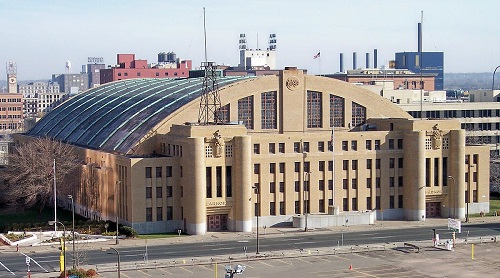The Armory
 Tuesday, June 4, 2019 at 3:33PM |
Tuesday, June 4, 2019 at 3:33PM |  Michael Rainville Jr |
Michael Rainville Jr | Article by Michael Rainville, Jr.
The Minneapolis Armory has a rather unique history. From being the home of the Minnesota National Guard to hosting world famous musical acts, the Armory has seen a lot in its day. There were moments when this magnificent work of architecture seemed to merely blend into the towering Minneapolis skyline that surrounded it and its importance was lost. Now that the building has made a comeback, let’s see where it all started.
 The Armory under construction, 1934
The Armory under construction, 1934
The Great Depression was one of the most debated topics during the United States presidential election of 1932. The U.S. economy was in shambles, and the candidates knew if they preached their plan to boost the economy, they would surly win the presidency. Once Franklin D. Roosevelt received the Democratic nomination, he began promising a new deal for the American people. Once he officially started his presidency, one of his first orders of business was to sign the First New Deal in 1933. Within this plan was the creation of the Public Works Administration, or PWA. The goal of the PWA was to spend $6 billion over the course of the next decade to build and improve infrastructure by using contracted skilled laborers. As a result of the PWA many notable structures were constructed, including the Hoover Dam, the majority of the Upper Mississippi locks & dams, the Lincoln Tunnel in New York City, the Overseas Highway connecting Key West, Florida, to the mainland, and the Minneapolis Armory.
The Armory was designed by P. C. Bettenburg, a graduate of St. Thomas College and Military Academy, now the University of St. Thomas. He was a major in the Minnesota National Guard, U. S. Army infantry regimental commander in North Africa and in Europe during World War II, and later the major general in command of the Viking Unit of the Minnesota National Guard. Because of the success of the Minneapolis Armory, once WWII was over he returned to St. Paul to open his own firm, which is credited with creating the master plan for the Camp Ripley Military Reservation and the armories of St. Paul, West St. Paul, and St. Cloud.
 Inaugural ceremonies at the Armory in 1935
Inaugural ceremonies at the Armory in 1935
Between 1935-36, the Minneapolis Armory was constructed using ashlar coursed granite, textured buff bricks, and Mankato limestone in the PWA Moderne Style, which traces its origins to the famous German design school, the Bauhaus. This style encompasses the Bauhaus’ train of thought that simplicity is best; form should be followed by function, and that is very apparent when viewing the Armory. Inside of the building are also two very impressive frescoes made possible by the Federal Art Project; one titled History of the National Guard by Lucia Wiley and the other titled Early Minnesota by Elsa Jemne. Once the building was complete, it ended up becoming the most expensive building in Minneapolis costing $932,453, or just over $17 million after inflation.
Throughout the years when it was used by the military the Armory held twenty-seven units of the Minnesota National Guard and Naval Militia, which include the 59th Field Artillery Brigade, the 68th Infantry Brigade, the 9th Battalion of the Minnesota Naval Militia, with the primary tenants being the entire 151st Field Artillery Regiment and numerous companies of the 135th Infantry Regiment. The later two are important to Minnesota and U.S. history as both were formed for the Civil War. The 151st is known for its continuous gun fire in France during the closing four months of World War I. They were led by Colonel George Leach, who later became a four-term mayor of Minneapolis. The 135th, which was originally designated as the 1st Infantry Regiment, is the state's oldest Guard unit and is known for its charge on Cemetery Ridge during the Battle of Gettysburg, which is recognized as one of the most courageous acts in American military history.
Another very popular tenant was the Minneapolis Lakers from 1947-60, who won five championships before their relocation to Los Angeles. The Minnesota National Guard moved away from the Armory in 1980, and in 1985 the building was officially added to the National Register of Historic Places. In 1989, Hennepin County bought it for $4.7 million intending to build a new county jail on the site. This intention led to the Minnesota Historical Society suing to stop its destruction and in 1993, the Minnesota Supreme Court ruled in favor of the Minnesota Historical Society citing the Armory’s inclusion in the National Register of Historic Places. During this down time, the Armory was used as the setting for Prince’s “1999” music video in 1982, and Aerosmith’s “I Don't Want to Miss a Thing” music video in 1998. That same year the Armory was sold to a private company for $2.6 million and used as a parking facility until 2015 when a local developer bought it for $6 million with plans to renovate it and turn it into an entertainment venue. Today the Armory holds 8,400 people for concerts, parties, and sporting events. It is once again a state-of-the-art venue that is a must see for anyone who lives in the Twin Cities.
 Photo of the Armory from 2006
Photo of the Armory from 2006
 Interior view taken during the Imagine Dragons concert in 2018
Interior view taken during the Imagine Dragons concert in 2018
- - - - - - - - - - - - - - - - - - - - - - - - - - - - - - - - - - - - - - - - - - - - - - - - - - - - - -
 About Michael Rainville, Jr.
About Michael Rainville, Jr.
A 6th generation Minneapolitan, Michael Rainville Jr. received his B.A. in History from the University of St. Thomas, and is currently enrolled in their M.A. in Art History and Certificate in Museum Studies programs.
Michael is also a lead guide at Mobile Entertainment LLC, giving Segway tours of the Minneapolis riverfront for 6+ years.
He can be reached at mrainvillejr@comcast.net.
